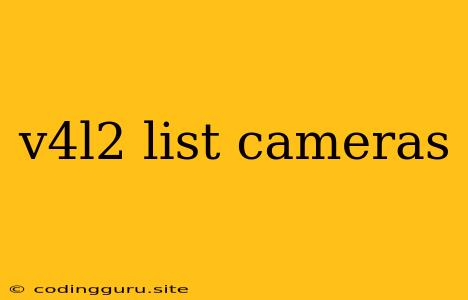How to List Available Cameras Using v4l2
The v4l2 (Video for Linux Two) driver is a powerful tool for working with video capture devices on Linux systems. It provides a standardized interface for accessing and controlling cameras, webcams, and other video capture devices. One common task when working with v4l2 is to list the available cameras connected to your system. This article will guide you through the process of listing cameras using the v4l2 driver.
What is v4l2?
v4l2 is a Linux kernel driver responsible for managing video capture and output devices. It provides a consistent interface for interacting with these devices, regardless of the underlying hardware. This means you can write applications that can work with different cameras and video capture devices without needing to know the specific details of each one.
Why List Cameras Using v4l2?
Listing the available cameras with v4l2 is an essential step for many tasks involving video capture, such as:
- Developing applications: You need to know which cameras are available to choose the right one for your application.
- Troubleshooting: If your application isn't working as expected, listing the available cameras can help you identify any problems with camera detection or connectivity.
- System administration: You might need to list the available cameras to configure them or manage them on your system.
Using the v4l2-ctl Tool
The v4l2-ctl command-line tool is the most straightforward way to list available cameras using v4l2. It provides a convenient interface for interacting with video capture devices.
Here's how to use v4l2-ctl to list cameras:
- Open a terminal: On your Linux system, open a terminal window.
- Run the command: Execute the following command:
v4l2-ctl --list-devices
- View the output: The output of the command will list the available video capture devices. Each device will be identified by its device node (e.g.,
/dev/video0).
Example Output:
v4l2-ctl --list-devices
ioctl: VIDIOC_QUERYCAP
ioctl: VIDIOC_ENUM_INPUT
ioctl: VIDIOC_ENUM_OUTPUT
ioctl: VIDIOC_ENUM_AUDIO
ioctl: VIDIOC_ENUM_AUDOUT
ioctl: VIDIOC_QUERY_EXT_CTRLS
ioctl: VIDIOC_QUERY_CTRL
ioctl: VIDIOC_G_CTRL
ioctl: VIDIOC_S_CTRL
ioctl: VIDIOC_G_INPUT
ioctl: VIDIOC_S_INPUT
ioctl: VIDIOC_QUERYMENU
ioctl: VIDIOC_G_MENU
ioctl: VIDIOC_S_MENU
ioctl: VIDIOC_QUERYSTD
ioctl: VIDIOC_ENUMSTD
ioctl: VIDIOC_G_STD
ioctl: VIDIOC_S_STD
ioctl: VIDIOC_ENUM_FRAMESIZES
ioctl: VIDIOC_ENUM_FRAMEINTERVALS
ioctl: VIDIOC_G_PARM
ioctl: VIDIOC_S_PARM
ioctl: VIDIOC_G_FMT
ioctl: VIDIOC_S_FMT
ioctl: VIDIOC_REQBUFS
ioctl: VIDIOC_QUERYBUF
ioctl: VIDIOC_QBUF
ioctl: VIDIOC_DQBUF
ioctl: VIDIOC_STREAMON
ioctl: VIDIOC_STREAMOFF
ioctl: VIDIOC_TRY_FMT
ioctl: VIDIOC_G_FBUF
ioctl: VIDIOC_S_FBUF
ioctl: VIDIOC_EXPBUF
ioctl: VIDIOC_G_SELECTION
ioctl: VIDIOC_S_SELECTION
ioctl: VIDIOC_G_CROP
ioctl: VIDIOC_S_CROP
ioctl: VIDIOC_CROPCAP
ioctl: VIDIOC_G_JPEGCOMP
ioctl: VIDIOC_S_JPEGCOMP
ioctl: VIDIOC_QUERY_EXT_EVENT
ioctl: VIDIOC_SUBSCRIBE_EVENT
ioctl: VIDIOC_UNSUBSCRIBE_EVENT
ioctl: VIDIOC_ENUM_FRAMESIZES
ioctl: VIDIOC_ENUM_FRAMEINTERVALS
ioctl: VIDIOC_G_PARM
ioctl: VIDIOC_S_PARM
ioctl: VIDIOC_G_FMT
ioctl: VIDIOC_S_FMT
ioctl: VIDIOC_REQBUFS
ioctl: VIDIOC_QUERYBUF
ioctl: VIDIOC_QBUF
ioctl: VIDIOC_DQBUF
ioctl: VIDIOC_STREAMON
ioctl: VIDIOC_STREAMOFF
ioctl: VIDIOC_TRY_FMT
ioctl: VIDIOC_G_FBUF
ioctl: VIDIOC_S_FBUF
ioctl: VIDIOC_EXPBUF
ioctl: VIDIOC_G_SELECTION
ioctl: VIDIOC_S_SELECTION
ioctl: VIDIOC_G_CROP
ioctl: VIDIOC_S_CROP
ioctl: VIDIOC_CROPCAP
ioctl: VIDIOC_G_JPEGCOMP
ioctl: VIDIOC_S_JPEGCOMP
ioctl: VIDIOC_QUERY_EXT_EVENT
ioctl: VIDIOC_SUBSCRIBE_EVENT
ioctl: VIDIOC_UNSUBSCRIBE_EVENT
ioctl: VIDIOC_ENUM_FRAMESIZES
ioctl: VIDIOC_ENUM_FRAMEINTERVALS
ioctl: VIDIOC_G_PARM
ioctl: VIDIOC_S_PARM
ioctl: VIDIOC_G_FMT
ioctl: VIDIOC_S_FMT
ioctl: VIDIOC_REQBUFS
ioctl: VIDIOC_QUERYBUF
ioctl: VIDIOC_QBUF
ioctl: VIDIOC_DQBUF
ioctl: VIDIOC_STREAMON
ioctl: VIDIOC_STREAMOFF
ioctl: VIDIOC_TRY_FMT
ioctl: VIDIOC_G_FBUF
ioctl: VIDIOC_S_FBUF
ioctl: VIDIOC_EXPBUF
ioctl: VIDIOC_G_SELECTION
ioctl: VIDIOC_S_SELECTION
ioctl: VIDIOC_G_CROP
ioctl: VIDIOC_S_CROP
ioctl: VIDIOC_CROPCAP
ioctl: VIDIOC_G_JPEGCOMP
ioctl: VIDIOC_S_JPEGCOMP
ioctl: VIDIOC_QUERY_EXT_EVENT
ioctl: VIDIOC_SUBSCRIBE_EVENT
ioctl: VIDIOC_UNSUBSCRIBE_EVENT
ioctl: VIDIOC_ENUM_FRAMESIZES
ioctl: VIDIOC_ENUM_FRAMEINTERVALS
ioctl: VIDIOC_G_PARM
ioctl: VIDIOC_S_PARM
ioctl: VIDIOC_G_FMT
ioctl: VIDIOC_S_FMT
ioctl: VIDIOC_REQBUFS
ioctl: VIDIOC_QUERYBUF
ioctl: VIDIOC_QBUF
ioctl: VIDIOC_DQBUF
ioctl: VIDIOC_STREAMON
ioctl: VIDIOC_STREAMOFF
ioctl: VIDIOC_TRY_FMT
ioctl: VIDIOC_G_FBUF
ioctl: VIDIOC_S_FBUF
ioctl: VIDIOC_EXPBUF
ioctl: VIDIOC_G_SELECTION
ioctl: VIDIOC_S_SELECTION
ioctl: VIDIOC_G_CROP
ioctl: VIDIOC_S_CROP
ioctl: VIDIOC_CROPCAP
ioctl: VIDIOC_G_JPEGCOMP
ioctl: VIDIOC_S_JPEGCOMP
ioctl: VIDIOC_QUERY_EXT_EVENT
ioctl: VIDIOC_SUBSCRIBE_EVENT
ioctl: VIDIOC_UNSUBSCRIBE_EVENT
ioctl: VIDIOC_ENUM_FRAMESIZES
ioctl: VIDIOC_ENUM_FRAMEINTERVALS
ioctl: VIDIOC_G_PARM
ioctl: VIDIOC_S_PARM
ioctl: VIDIOC_G_FMT
ioctl: VIDIOC_S_FMT
ioctl: VIDIOC_REQBUFS
ioctl: VIDIOC_QUERYBUF
ioctl: VIDIOC_QBUF
ioctl: VIDIOC_DQBUF
ioctl: VIDIOC_STREAMON
ioctl: VIDIOC_STREAMOFF
ioctl: VIDIOC_TRY_FMT
ioctl: VIDIOC_G_FBUF
ioctl: VIDIOC_S_FBUF
ioctl: VIDIOC_EXPBUF
ioctl: VIDIOC_G_SELECTION
ioctl: VIDIOC_S_SELECTION
ioctl: VIDIOC_G_CROP
ioctl: VIDIOC_S_CROP
ioctl: VIDIOC_CROPCAP
ioctl: VIDIOC_G_JPEGCOMP
ioctl: VIDIOC_S_JPEGCOMP
ioctl: VIDIOC_QUERY_EXT_EVENT
ioctl: VIDIOC_SUBSCRIBE_EVENT
ioctl: VIDIOC_UNSUBSCRIBE_EVENT
/dev/video0:
driver: uvcvideo
card: Logitech C920 HD Pro Webcam
bus_info: usb-0000:00:14.0-1.4
device: 1209:c503
vendor: Logitech
model: C920
serial: 000000000000
width: 1920
height: 1080
pixelformat: YUYV
/dev/video1:
driver: uvcvideo
card: USB Video Device
bus_info: usb-0000:00:14.0-1.6
device: 046d:0825
vendor: Logitech
model: QuickCam Pro for Notebooks
serial: 000000000000
width: 640
height: 480
pixelformat: YUYV
Understanding the Output:
The output of the v4l2-ctl command shows information about each detected video device. Here's a breakdown of the important fields:
driver: The name of the kernel driver responsible for the device.card: The name of the video capture card.bus_info: The bus and device information for the camera.device: The vendor and product IDs for the camera.vendor: The name of the camera manufacturer.model: The model name of the camera.serial: The serial number of the camera, if available.width: The maximum width (in pixels) the camera can capture.height: The maximum height (in pixels) the camera can capture.pixelformat: The default pixel format supported by the camera.
Troubleshooting Tips:
If you're having trouble listing cameras using v4l2, here are some troubleshooting tips:
- Check the driver: Ensure that the v4l2 driver is installed and loaded correctly.
- Permissions: Make sure your user account has the necessary permissions to access the video capture devices.
- Hardware: Verify that the camera is properly connected to your system and powered on.
Conclusion:
Listing available cameras using v4l2 is a straightforward process using the v4l2-ctl command. This information is essential for developing applications, troubleshooting problems, and managing video capture devices on your Linux system. By understanding the output of the command and following the troubleshooting tips, you can successfully list available cameras and begin working with them.
